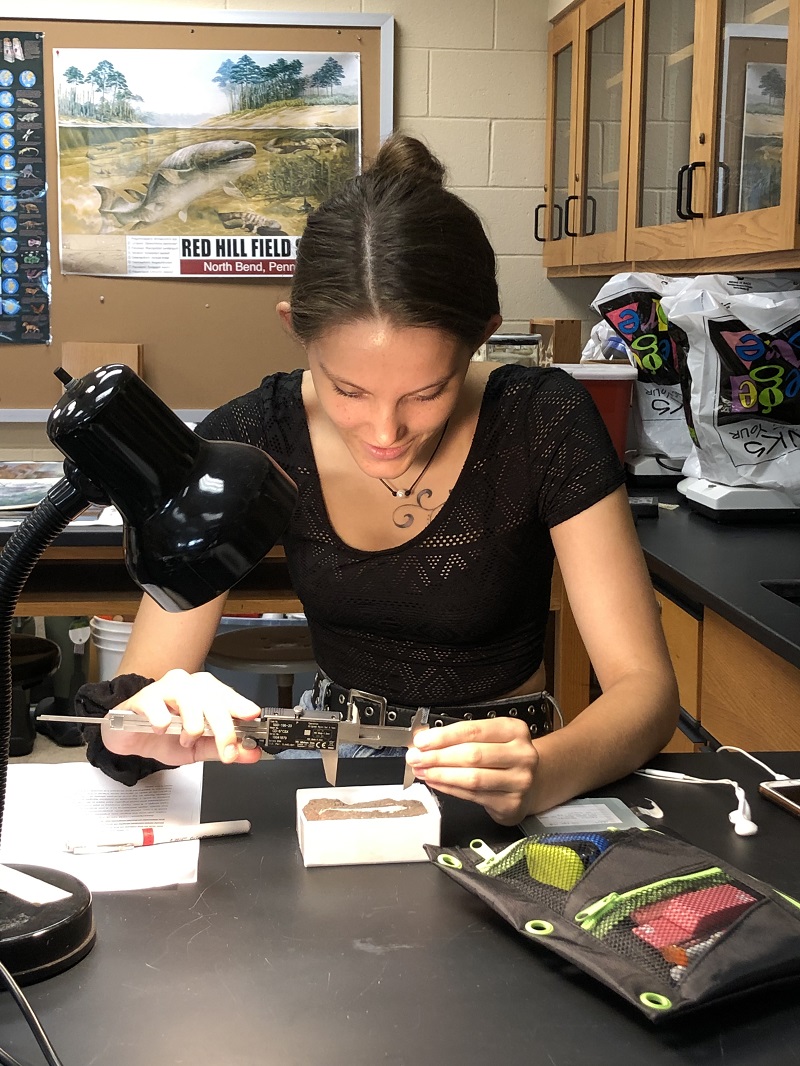
Kennedy measures jaw specimen
Download Image: Web
A research paper written by a faculty-student duo from Lycoming College was recently published online in the Journal of Vertebrate Paleontology, in collaboration with additional paleontologists. The paper, “First records of Ischnacanthiformes (“Acanthodii”) from the Upper Devonian Catskill Formation in north-central Pennsylvania, USA,” details recently discovered jaw specimens of acanthodians, a group of extinct fishes commonly known as “spiny sharks” that lived from approximately 442 to 252 million years ago.
Lycoming College’s David Broussard Ph.D., associate professor of biology, and Sage Kennedy ’25, a biology major and painting minor from Hughesville, Pa., who assisted with fieldwork and created artistic reconstructions of the jaw specimens for the manuscript, teamed up with Carole Burrow, Ph.D., from the Queensland Museum in Brisbane, Australia, who is the world’s expert on ischnacanthid acanthodians, to identify and describe these jaw specimens. Other coauthors included Jeffrey Trop, Ph.D., professor of geology and environmental geosciences at Bucknell University; Edward Daeschler, Ph.D., professor of biodiversity, earth and environmental science at Drexel University and curator of vertebrate zoology at the Academy of Natural Sciences; and Pierre Zippi, Ph.D., paleobotanist and research professor at Southern Methodist University.
According to Broussard, acanthodians are a group of fossils fishes closely related to modern cartilaginous fishes (sharks and rays) that lived from the Early Silurian Period (about 442 million years ago) through the Late Permian Period (about 270 - 255 million years ago). Many different types of acanthodians have been described from the fossil record, including a group known as the ischnacanthids, which became extinct by the end of the Devonian Period. These types of predatory acanthodians possessed bony jaws that held large fang-like teeth used for catching and consuming prey.
Ischnacanthids have been identified from many sites globally that date from the Late Silurian Period (about 420 million years ago) to the Late Devonian Period (380 - 350 million years ago). Fossil evidence suggests that these ancient fishes lived in a variety of coastal habitats including shallow marine, brackish, and freshwater environments.
“Three of the ischnacanthid jaw specimens described in the paper were collected by myself and colleagues (including former student Tamara Hess ’23) over the last few years at sites in Lycoming, Tioga, and Bradford Counties,” said Broussard. “The other was collected in 1918 near Factoryville in Pennsylvania’s Wyoming County. I discovered this specimen, which is cataloged at the Peabody Museum of Natural History at Yale after “digging” though their collections database a few years ago. These specimens represent some of the youngest ischnacanthids ever to be collected globally. Additonally, we identified two of the ischnacanthid jaw specimens as belonging to the genus Persacanthus which had not been previously collected from rocks as young as those at our study areas in north-central Pennsylvania.”
The paper can be read in full at: https://www.tandfonline.com/eprint/9TMQNDIFFZWKRIWDPGRI/full?target=10.1080/02724634.2023.2212009
Lycoming College’s biology program recognizes that the field is every-changing by providing a cutting-edge curriculum that actively engages students in studying the diversity of life, while giving them the analytical skills to answer tomorrow’s questions. From the moment they step into their first biology class, students benefit from experience with advanced instrumentation in labs and are invited to become involved in active research so they can develop their skills over all four years. The biology program’s innovative coursework prepares students for professions in the fields of research, education, healthcare, neuroscience, biotechnology, and the environment, and students are provided opportunities for internships and co-curricular professional experiences, collaborative student-faculty research, and exposure to first-rate biological instrumentation. More information is available at https://www.lycoming.edu/biology/.

Broussard with Lycoming students: Kennedy, Nidhee Seernaum, Olivia Plotts, Chris Graham, on a vertebrate biology field trip fall 2022

Fossil images of ischnacanthid acanthodian jaws with artistic reconstructions created by Kennedy

Artistic reconstruction of an ischnacanthid acanthodian created by Broussard